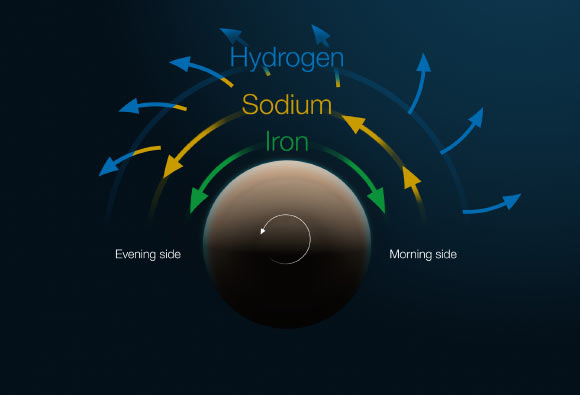Ultrahot Jupiters, an extreme class of planets not found in our Solar System, provide a unique window into atmospheric processes. Using four telescope units of ESO’s Very Large Telescope, astronomers have now probed deep inside the atmosphere of the ultrahot-Jupiter exoplanet WASP-121b and revealed distinct powerful winds in separate layers, forming a map of the atmosphere’s 3D structure.
WASP-121b is a gas-giant exoplanet 1.87 times bigger than Jupiter and 1.18 times more massive.
First discovered in 2016, this alien world takes just 1.3 days to orbit its parent F6-type star, WASP-121 (TYC 7630-352-1).
The WASP-121 system is located about 881 light-years away in the constellation of Puppis.
WASP-121b is a so-called ‘ultrahot Jupiter’ and takes just 1.3 days to orbit WASP-121. It is so close to the parent star that if it got any closer, the star’s gravity would start ripping it apart.
Astronomers estimate the planet’s temperature to be about 2,500 degrees Celsius (4,600 degrees Fahrenheit), hot enough to boil some metals.
“WASP-121b’s atmosphere behaves in ways that challenge our understanding of how weather works — not just on Earth, but on all planets,” said Dr. Julia Victoria Seidel, an astronomer at ESO and the Lagrange Laboratory, part of the Observatoire de la Côte d’Azur.
“It feels like something out of science fiction.”
“What we found was surprising: a jet stream rotates material around the planet’s equator, while a separate flow at lower levels of the atmosphere moves gas from the hot side to the cooler side.”
“This kind of climate has never been seen before on any planet.”
“The observed jet stream spans half of the planet, gaining speed and violently churning the atmosphere high up in the sky as it crosses the hot side of WASP-121b.”
“Even the strongest hurricanes in the Solar System seem calm in comparison.”
To uncover the 3D structure of WASP-121b’s atmosphere, Dr. Seidel and colleagues used the…
Read the full article here





